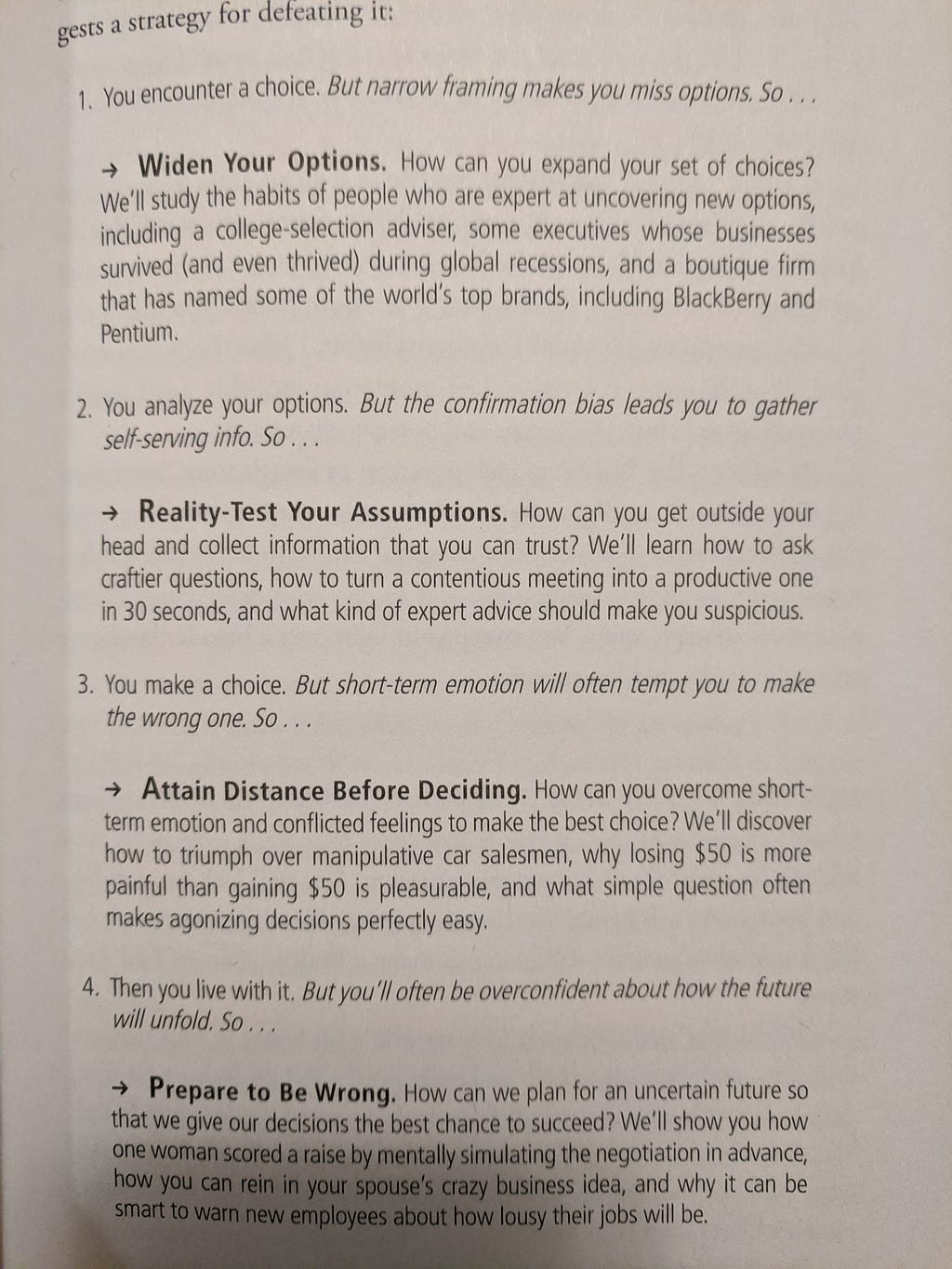Book Review: Decisive by Chip and Dan Heath
post by Ian David Moss · 2020-02-06T20:15:53.000Z · LW · GW · 0 commentsContents
No comments

I first heard of the Heath brothers (Chip and Dan) years ago when I saw Chip speak about their first two books, Made to Stick and Switch. So I was pleased to discover that they’ve written a book specifically about decision-making called Decisive.
I like Decisive primarily as an introductory take on personal decision-making. It’s also a good supplemental resource for organizational and business applications, though there are other books that offer a more thorough grounding in that arena.
According to the Heaths, the “four villains of decision-making” are as follows:
- narrow framing (not thinking about enough options)
- confirmation bias in gathering information
- overweighting short-term emotions (such as discomfort or fear); and
- overconfidence.
To combat these problems, the authors dreamed up the WRAP method, a slightly ungainly mnemonic that stands for Widen your options, Reality-test your assumptions, Attain distance before deciding, and Prepare to be wrong.

Having read a fair amount on decision-making prior to encountering Decisive, I found the first section on widening options to be most illuminating. Most decisions we make are in the form of “whether or not”: in a 1993 study by Nutt, only 29% of teams considered more than one alternative. Yet a University of Kiel study found multi-option decision processes resulted in six times as many “very good” decisions (as rated retrospectively by the decision-makers) as single-option processes.
So how do you generate more options? The Heaths suggest using the actual phrase “whether or not” as an automatic mental trigger that more options are needed. It’s also helpful to think about opportunity costs — what else could you do with the money/time? One study showed that just prompting people to think about opportunity costs caused a significant number to change purchasing intentions. Or try the Vanishing Options Test: pretend you can’t choose any of your current options — what do you do instead?
The authors make clear that decision paralysis is a real thing and they are not advocating for unlimited options, just one or two more than you would otherwise consider. Or you can figure that you’ll keep considering options until you “fall in love” with at least two of them.
“Prepare to be wrong” (the P in WRAP) is another relatively neglected piece of wisdom in my experience. This section of the book was a little unfocused, but covers some scenario planning methods like Failure Modes and Effects Analysis (FMEA).
Decisive offers some neat heuristics that I haven’t seen elsewhere, like 10/10/10: how will I feel about this choice in 10 minutes/10 months/10 years? There’s also useful advice for choosing a reference class: pick the narrowest category that still gives you 10–20 examples. Likewise, I appreciated the idea to create a “stop doing” list (to help clarify priorities) and to consider what your calendar says about your priorities. (I’ve heard the same said about budgets for organizations.)
Finally, there was a good lesson about procedural justice: when people perceive a decision process as fair, they’re as happy with an unfavorable outcome as people who get a favorable outcome from a process that they perceived as unfair. Good to know!
In the appendix, the authors contemplate what a super-slimmed-down version of the WRAP method might look like when you don’t have a lot of time to work with:
- Think of one more option
- Call one expert to get a sense of the relevant base rate/reference class
- Consider your core values
- Think of a good and bad scenario for how it could turn out, and prepare for each.
Honestly, that’s pretty solid advice. The book does ramble at points, and definitely comes across with a “Chip and Dan’s latest deliverable for their publisher” vibe more than “OMG this is my labor of love and summation of my life’s work and I hope you, dear reader, will adore it the way I do!!!” I was frankly hoping for a bit more passion and editorial rigor throughout. Still, Decisive is worth buying or browsing for the framework, the stories, and the insights I cited above. If you get it, let me know what you thought!
0 comments
Comments sorted by top scores.